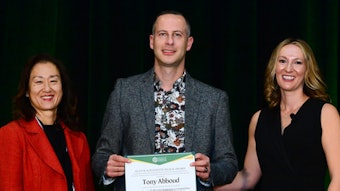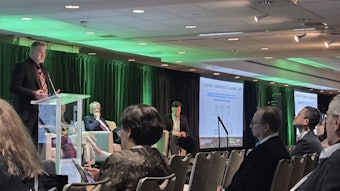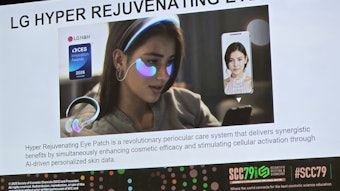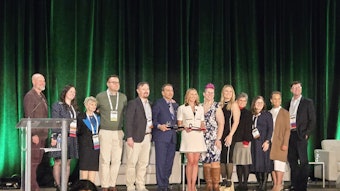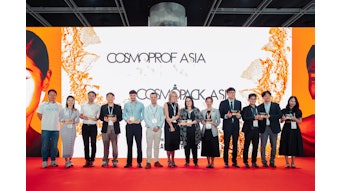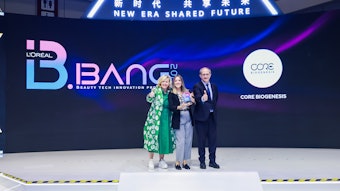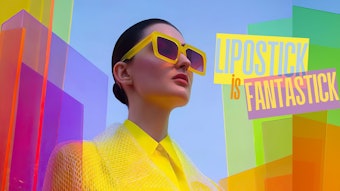The Midwest chapter of the Society of Cosmetic Chemists (MWSCC) knocked another TeamWorks out of the park with unprecedented attendance to its social night, education session and exhibition. Before the education session and exhibition were under way, the chapter hosted its annual Social Night on Mar. 30, 2010, with a "Roaring 20s" theme. The night began with cocktails and gambling in a room filled with black jack, roulette, craps and poker tables. Attendees then shifted their focus, although briefly, to a number of pasta, meat-carving and dessert stations, before testing their luck again at a hand, or two or three.
During the festivities, a scuffle occurred between a few gangsters and "coppers," much to a sobbing flapper's dismay. In the end, the guilty parties were hauled away in handcuffs and evening broke back into a gaming mode. At the end of the evening, chips won at the tables were traded in for raffle tickets, and a few lucky attendees walked away with either a GPS, an iPod or the grand prize, a Nintendo Wii, which was presented to Michael Wright of Alberto-Culver. After the Social Night venue closed, MWSCC members and guests retired to get a good night's rest for the following day's morning education session.
On March 31, the morning education session, themed “Formulating for Marketing Demands,” featured presentations from some of the top US personal care manufacturers. After TeamWorks education co-chair Gene Frank, PhD, (Raani Corp.) gave opening remarks, keynote presenter Peggy Ward, manager of corporate sustainability programs at Kimberly-Clark, took to the podium to present her company’s efforts to sustainably produce personal care products by reducing waste and using less energy. However, according to Ward, “You can’t just make a diaper overnight that is 100% biodegradable.” She furthered that in order to make its Huggies diapers more eco-friendly, Kimberly-Clark redesigned them with less material, thereby decreasing the amount of material that is disposed, in addition to reducing total weight of shipments.
The company also launched a diaper that is constructed with organic cotton, aloe and vitamin E. To design products that better benefit the environment, Ward noted that companies must assess the life cycle of their products. She noted that 86% of consumers are interested in green products, with 41% of those being "very" interested. She emphasized, “We are now formally including sustainability into every business aspect … it is obvious to every employee.” But it is not always the big efforts that count, according to Ward. “Any little thing you can do helps.”
Natural and green are marketing claims often seen on personal care products; however, it seems free-from appears just as frequently. Addressing the free-from conundrum was Tim Kapsner, senior research scientist at Aveda, who began his presentation with an exhaustive list of free-from claims. He ended this list with “free-from chemicals,” clearing pointing out the absurdity of some claims since everything is based on chemistry, even water, to which the audience broke out in laughter.
Kapsner provided a formulation from a hand soap he formulated in the 1970s commenting, “Little did I know that my liquid soap in 1970 would be a poster child for free-from.” He noted that with formaldehyde and some other chemicals, cross-contamination from a number of consumer products is more of a problem than exposure from one personal care product alone. Also, according to Kapsner, some chelators and preservatives continue to serve their function in the waste stream, possibly affecting the environment. Preservatives, however, are an obvious necessity. Kapsner noted, “You have to decide if you want to be preservative-free or microbiological contamination-free.” He concluded that chemists need to educate consumers about which chemicals pose health risks and which do not.
The session then took a short coffee break, during which Rachel Grabenhofer, senior editor of Cosmetics & Toiletries magazine and TeamWorks education co-chair, presented a check on behalf of the magazine as a donation to the MWSCC's educational activities. Accepting on behalf of the MWSCC were Gene Frank and MWSCC Chair Cinda Carlson (Concept Labs).
Reconvening from the break, the discussion then shifted to sensitive skin with a presentation by Russel Walters, PhD, of Johnson & Johnson (J&J). Walters dissected the term sensitive skin, noting that for J&J, the term mostly applies to babies. Sensitive skin, according to Walters, can be dermatitis, inflammation of skin or skin having a reduced barrier. Walters simplified that definition to: "Sensitive skin is skin that requires less aggressive cleansing.” To cleanse sensitive skin, Walters recommended reducing the surfactant load since cleansers can remove barrier components and remain in the skin. Walters and his colleagues at J&J address remaining surfactants with hydrophobically modified polymers. These polymers reportedly lessen irritation by reducing the penetration of surfactants into the skin. In addition, Walters noted novel work under way with relation to micelles and their mechanisms to improve the mildness of cleansers on sensitive skin.
Moving from the skin discussion, Ali Syed, PhD, founder of Avlon Industries, spoke on his area of expertise, ethnic hair care. Syed defined ethnic hair as “excessively curly hair.” He described the differences in diameter, ellipticity and oil distribution of African, Caucasian and Brazilian hair. In addition, Syed gave some formulating tips on creating products for ethnic hair, noting that alcohols are “deadly” for African hair. The combination of silicones and laminates, however, better accompanies the blow dry maintenance of African hair, according to Syed.
The final speaker of the morning was Michael Wright, project leader on the Nexxus Salon hair care brand for Alberto-Culver. Sensory claims were the focus of Wright’s presentation. According to Wright, product technology and sensory signals add to the consumer's experience and since consumers use their senses to test the product before purchasing it, Wright recommended that product formulators consider the consumers' current vs. ideal experiences. He noted that formulators must understand the drivers behind what makes a consumer like a product and suggested that all formulators think about the sensory interactions consumers have during each stage of experience with the product—i.e., from sniffing the product in the bottle on the store shelf, to feeling it in their hands before applying it, to lasting effects such as its scent and feel after hours have passed.
Grabenhofer wrapped up the session with closing remarks, noting, "We're really happy with the turnout this year. I think this is the most attendees we've hosted at this education session to date"; approximately 200 attendees filled the conference hall.
Following the morning conference, attendees shuffled over to a sold-out exhibition. Raw material suppliers, testing companies, distributors and even one university, among others, showcased their products and services at more than 115 booths. Exhibitors and attendees alike networked, socialized, even competed with booth bingo and, in one case, on a Nintendo Wii for valuable prizes. After a full day of visiting booths, attendees left with bags full of product literature, formulation samples and other fun give-aways; such as a personalized fragrance or soap created at the show by Orchidia Fragrances. The event drew 800+ pre-registrations in total, truly packing the personal care house.

